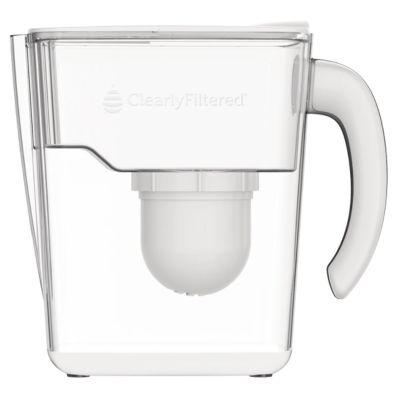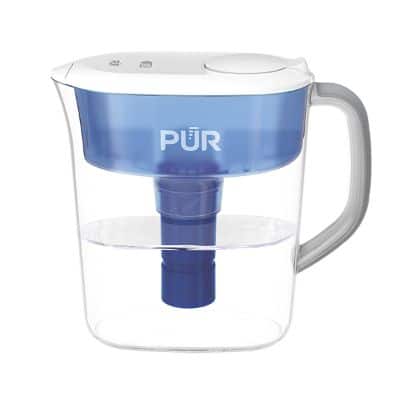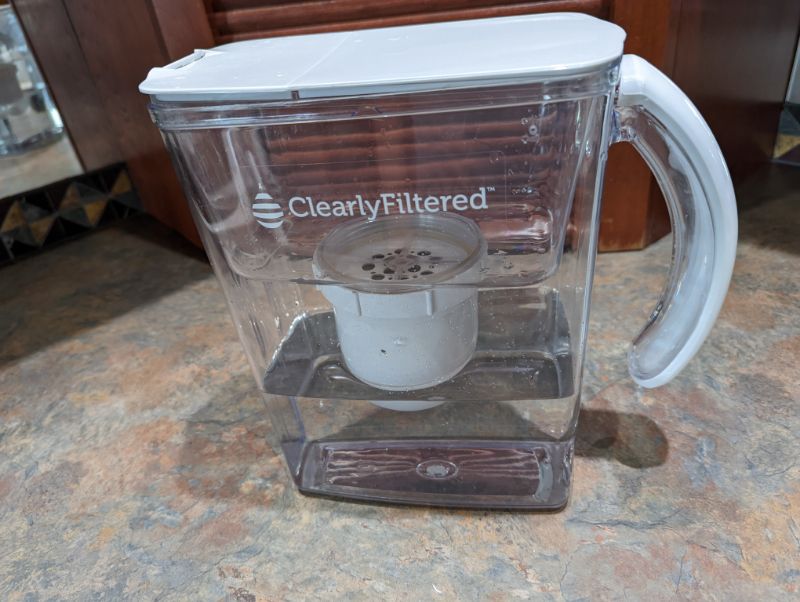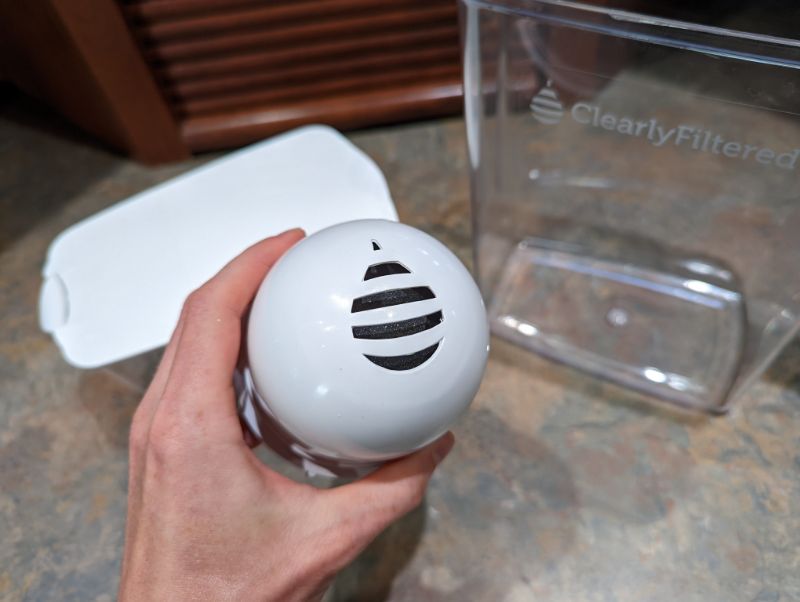Clearly Filtered is one of the most expensive water filter pitcher brands, while PUR is one of the most affordable. But how do these systems compare performance-wise, and which offers the best value for money?
We’ve put the Clearly Filtered vs PUR Plus pitchers head to head, using our own testing data to evaluate both systems in this review.

Clearly Filtered
Best For:

PUR Plus
Best For:
In our testing, Clearly Filtered had the sturdiest design and reduced many more contaminants than PUR, but it also introduced an unwanted contaminant. The PUR Plus pitcher reduced fewer contaminants but didn’t leach any impurities into our filtered water. It’s also certified to reduce more contaminants than the CF pitcher.
Table of Contents
📊 Our Testing Data
At Water Filter Guru, our extensive reviewing process involves using our own test data to assess water filters across 6 key performance categories. Here’s how Clearly Filtered PUR compare in these categories.
| Factor | Clearly Filtered | PUR Plus |
|---|---|---|
| Contaminant Reduction | 8.24 | 5.28 |
| Filtration Rate | 10.00 | 10.00 |
| Design | 9.70 | 8.80 |
| Setup | 9.50 | 9.50 |
| Maintenance | 8.75 | 9.75 |
| Company | 9.00 | 7.50 |
Our scoring system utilizes data from over a dozen testing sub-categories. We’ve shared a breakdown of this data in the table below, so you can see exactly how we reached the overall scores for both pitchers.
| Factor | Clearly Filtered | PUR Plus | Winner |
|---|---|---|---|
| Overall Score | 8.78 | 7.08 | Clearly Filtered |
| Health Related Contaminants | 8.30 | 4.50 | Clearly Filtered |
| Aesthetic Related Contaminants | 9.90 | 9.50 | Clearly Filtered |
| Performance Certification | NSF/ANSI 42 & 53 | NSF/ANSI 42, 53 & 401 | PUR |
| Filtration Rate | 2.27 GPH | 2.82 GPH | PUR |
| Component Quality | Outstanding | Fair | Clearly Filtered |
| Component Certification | NSF/ANSI 42, 53, & 372 | NSF/ANSI Certified | Clearly Filtered |
| Setup | Outstanding | Outstanding | Tie |
| Servicing Requirements | Outstanding | Outstanding | Tie |
| Costs | $0.55/ gal | $0.27/ gal | PUR |
| Warranty Length | 2 years | 90 days | Clearly Filtered |
| Shipping | Free shipping to all states | Depends on the distributor | Clearly Filtered |
| Returns | 30 days | None | Clearly Filtered |
🚰 Contaminant Reduction
We start our testing with the most important measure of performance: contaminant reduction.
We used a water quality test to find out which contaminants were present in our unfiltered water. We filtered it through the Clearly Filtered and PUR systems, then tested a water sample from each pitcher.
The overall score for the filters was also influenced by whether or not they had obtained an official performance certification from the WQA, NSF, or IAPMO for their contaminant reduction claims.
Our Lab Test Results
We tested the PUR Plus and Clearly Filtered pitchers using the same water source: treated groundwater from a shared well. We used SimpleLab Tap Score laboratory tests to ensure a highly accurate contaminant detection process.

Our results were highlighted in our Tap Score interactive reports. We chose to compare the concentrations of the contaminants detected with Tap Score’s Health Guideline Levels (HGLs), which prioritize human health and are stricter than the EPA MCL.
The table below lists the contaminants detected in our unfiltered water and both filtered water samples.
| Contaminant | Measurement | Untreated Water | Clearly Filtered | % Change | PUR | % Change |
|---|---|---|---|---|---|---|
| Chloride | PPM | 14.9 | 15.5 | 4.03% | 14.8 | -0.67% |
| Chlorine | PPM | 1 | 0 | -100.00% | 0 | -100.00% |
| Fluoride | PPM | 1.1 | 0 | -100.00% | 1.1 | 0.00% |
| Nitrate (as N) | PPM | 3.5 | 3.1 | -11.43% | 2 | -42.86% |
| Phosphorus | PPM | 1 | 0 | -100.00% | 1.2 | 20.00% |
| Sulfate | PPM | 8.4 | 8.1 | -3.57% | 8 | -4.76% |
| Barium | PPM | 0.0158 | 0.0022 | -86.08% | 0.0151 | -4.43% |
| Cobalt | PPM | 0 | 0.0054 | n/a | ND | ND |
| Copper | PPM | 0.163 | 0 | -100.00% | 0.0028 | -98.28% |
| Molybdenum | PPM | 0.0026 | 0.0012 | -53.85% | 0.002 | -23.08% |
| Strontium | PPM | 0.11 | 0.036 | -67.27% | 0 | -100.00% |
| Uranium | PPM | 0.014 | 0 | -100.00% | 0.0028 | -80.00% |
| Calcium | PPM | 25.6 | 17.2 | -32.81% | 1 | -96.09% |
| Magnesium | PPM | 6.32 | 10.4 | 64.56% | 0.32 | -94.94% |
| Potassium | PPM | 0 | 2.53 | n/a | 1.66 | n/a |
| Sodium | PPM | 9.63 | 14.3 | 48.49% | 47 | 388.06% |
The Clearly Filtered got the best score by a mile here because it did a much better job at reducing the contaminants present in our water.
Health-Related Contaminants
First, we evaluated the pitchers’ reduction of health-related contaminants in our water, which we were the keenest to remove.
8 health-related contaminants were detected, including fluoride and uranium, which were both detected at levels above the Tap Score HGL.
The table below highlights all the contaminants with health effects in our water.
| Contaminant | Measurement | Detection | HGL |
|---|---|---|---|
| Fluoride | PPM | 1.1 | 0.8 |
| Uranium | PPM | 0.014 | 0.0 |
| Nitrate | PPM | 3.5 | 10 |
| Barium | PPM | 0.0158 | 2.0 |
| Molybdenum | PPM | 0.0026 | 0.03 |
| Strontium | PPM | 0.11 | 3.0 |
| Sulfate | PPM | 8.4 | 500 |
| Copper | PPM | 0.163 | 0.3 |
The Clearly Filtered pitcher reduced 100% of uranium and fluoride, as well as 100% copper, 86% barium, 67% strontium, 53% molybdenum, 11% nitrate, and 3% sulfate. It was one of the top-performing water filter pitchers we tested for reducing health-related contaminants.
But one testing outcome pulled down the filter’s score in this category. 0.0054 PPM of cobalt was detected in our filtered water – an unexpected result given that the pitcher has been third-party tested to reduce this heavy metal by >98.31%. Cobalt wasn’t detected in our unfiltered water, so we think it must have come from the filter media.
The PUR Plus pitcher actually did better than Clearly Filtered at reducing strontium by 100% and nitrate by 42%. But otherwise, it didn’t quite match up to the CF pitcher, reducing copper by 98%, uranium by 80%, molybdenum by 23%, and sulfate and barium by just 4%. It was unable to reduce the fluoride at all.
Does that mean the Clearly Filtered pitcher is more capable of reducing health-related contaminants overall compared to the PUR Plus pitcher? We can’t say this for certain because we’ve only tested both systems with a single water source. All we know is that the CF pitcher is better at reducing the specific contaminants that were found in our water.
PUR doesn’t claim that its filter can reduce most of the impurities detected in our water. Judging by the contaminants it’s certified to reduce, we think it’s a better choice for filtering treated water that isn’t necessarily from a groundwater source.
Regardless of your water source, it’s really important to test it for contaminants to make sure that a specific filter can effectively address the impurities present.
Aesthetic Contaminants
Clearly Filtered and PUR both eliminated aesthetic contaminants in our water.
The Tap Score kit we used came with a chlorine test strip, which detected around 1 PPM of free chlorine in our tap water.

After filtering through both the Clearly Filtered and PUR Plus pitchers, our water contained 0 PPM. Both filters have an activated carbon element, which is widely considered the best method of addressing chlorine tastes and odors in water.
Minerals & Ions
We wondered whether the Clearly Filtered and PUR Plus pitchers might also reduce contaminants that don’t have health effects, like our water’s natural minerals.
Clearly Filtered states that its pitcher targets harmful contaminants “without removing beneficial minerals”. So we were surprised to see that it reduced:
- Calcium by 32%
- Magnesium by 64%
- Sodium by 42%
We saw a small 2.5% increase in potassium, so we think the filter might use a potassium-loaded cation exchange resin. However, this increase was too small for us to say for certain.
The PUR Plus pitcher reduced even greater concentrations of healthy minerals:
- Magnesium by 95%
- Calcium by 96%
Our water’s sodium concentration increased by 388%, from 9.63 PPM to 47 PPM – a sure sign that the filter uses a sodium-loaded cation exchange resin. The filter appears to be exchanging sodium ions for unwanted ions – and calcium and magnesium ions were also reduced as a side effect.
Certifications
We’re only able to prove whether or not a water filter can address the contaminants detected in our own water.
For that reason, we also look for official performance certifications, which confirm a filter’s contaminant reduction abilities beyond the scope of our own testing.
Both Clearly Filtered and PUR have obtained performance certifications to support their contaminant reduction claims. But the PUR Plus pitcher got the best score here because it’s certified to reduce more contaminants than Clearly Filtered.
The PUR Plus pitcher is NSF certified to Standards 42, 53, and 401 for 100% of the contaminants that it’s claimed to reduce, including chlorine, tastes, and odors, zinc, particulates class I, cadmium, copper, mercury, and certain pesticides. Our only disappointment is that PUR has recently revoked its lead reduction certification – it has been replaced with a microplastics reduction certification.
The Clearly Filtered pitcher is WQA certified to NSF/ANSI Standard 42 and Standard 53, but it’s only certified for the reduction of 3 contaminants out of the hundreds listed on the performance datasheet.
🚦Filtration Rate
We compared Clearly Filtered and PUR’s filtration rates by timing how long they took to filter our water.
We’ve shared the filtration rate for both systems, measured in gallons per hour (GPH), in the table below.
| Product | Filtration Rate Score | Filtration Rate |
|---|---|---|
| Clearly Filtered | 10.00 | 2.27 GPH |
| PUR Plus | 10.00 | 2.82 GPH |
This was a close one, but PUR just scraped a win.
The average filtration rate of the 8 water filter pitchers we tested was 2.30 GPM.
The PUR Plus filtered 0.25 gallons of water in 5:19 minutes, giving it a filtration rate of 2.82 GPH. The Clearly Filtered pitcher treated 0.5 gallons of water in 13 minutes and 12 seconds, and we measured its filtration rate as 2.27 GPH.
Both filters had only been used for a few weeks when we tested them, so we expect their filtration rates will decrease slightly over time, as the filter media becomes clogged with contaminants.
💲 Upfront Cost
There’s a big price difference between the Clearly Filtered and PUR Plus pitchers.
We got the PUR Plus 7-cup pitcher for $26.99, which included the initial basic filter. We wanted to test the PUR Plus filter, so we purchased this separately (at an extra cost) to use for this project.
The Clearly Filtered pitcher cost $90, making it more than 3 times the price of PUR Plus, and one of the most expensive pitchers we’ve tested.
The CF pitcher holds 10 cups and has more extensive contaminant reduction claims, so we can’t directly compare these prices. In terms of value, we think this depends on your budget and the contaminants you want to reduce, but PUR is the best choice if you want to spend as little as possible.
PUR is only sold by third parties, so you may find it sold at different prices at different stores.
Here’s the price comparison for the two pitchers.
| Product | Price | Filters Included |
|---|---|---|
| Clearly Filtered Pitcher | $90.00 | 1 |
| PUR Plus 7-Cup Pitcher | $26.99 | 1 |
📐 Design
We wanted to know the key design differences between PUR and Clearly Filtered. There were two factors that contributed to our scoring in this category:
- How the systems looked and felt in terms of design quality
- Whether or not the systems were certified for materials safety
We also assessed their pitcher models and filter materials, although these didn’t affect their overall scores.
You can find our design scores for both filters in the next table.
| Product | Design Score | Component Quality | Materials Safety |
|---|---|---|---|
| Clearly Filtered | 9.70 | Outstanding | Certified |
| PUR Plus | 8.80 | Fair | Certified |
The Clearly Filtered pitcher got the highest design score because we were much more impressed with its construction quality.
Filter Models
Clearly Filtered sells just one 10-cup water filter pitcher, with no choice of colors – the pitcher is mostly clear, with a white lid and handle.

PUR provides slightly more variety, and the PUR Plus water filter can be used in the following systems:
- PUR Plus 7-cup pitcher $26.99
- PUR Plus 11-cup pitcher $37.49
- PUR Plus 12-cup pitcher $42.99 (only at Target)
- PUR PLUS 30 Cup Dispenser
PUR’s pitchers can be bought with different colored lids and handles, including blue, black, and grey.

You might prefer PUR if you like being able to choose from a few different pitcher models and styles, or if you want to upgrade to a system with a larger water-holding capacity. But the Clearly Filtered pitcher is a good size for most folks who want something that’s portable but still holds a good volume of water.
Component Quality
We noted that the Clearly Filtered pitcher had the best design quality of nearly all the pitchers we tested (only the LARQ PureVis came close).
The pitcher is made from scratch-resistant, BPA-free Tritan plastic. It felt thicker, sturdier, and more durable than the PUR Plus pitcher, which is made from NAS or SAN plastics (the filter housings and lids are made of BPA-free polypropylene) and felt thin and flimsy in comparison.
We recommend the Clearly Filtered pitcher if you want a system that should withstand years of use. It feels like it’s better made and should last longer than the PUR Plus – which suggests why there’s a big difference in price.
Both brands only sell plastic pitchers, so neither is the solution if you’re keen to limit your exposure to plastics.
Filter Materials & Media
From our research, we can deduce that Clearly Filtered has the more comprehensive filter design.
The CF filter combines activated carbon block media, a composite shell, a woven stainless steel mesh screen, and several proprietary materials. We think these are probably KDF media and some form of ion exchange resin, based on the contaminants that were reduced in our water.

PUR filters use granular activated carbon (ground-up carbon that is held together loosely rather than being pressed into a solid block), and they also contain an ion exchange resin.
Both filters house their media inside a plastic cartridge.

Materials Safety Certification
Both Clearly Filtered and PUR have obtained materials safety certifications as components of their performance certifications, giving them equally high scores in this category.
Clearly Filtered obtained its certification from the WQA, while the PUR Plus is certified by the NSF.
We felt reassured by these certifications. They tell us that a trusted third-party organization has tested the pitchers and determined that they’re safe and suitable for their purpose.
⚙️ Setup
Most of the water filter pitchers we’ve tried have been quick and easy to assemble, but there are usually still some differences, especially when it comes to the filter setup process.
We’ve shared our setup timings and scores for the PUR and Clearly Filtered systems below.
| Product | Setup Score | Setup Time |
|---|---|---|
| Clearly Filtered | 9.50 | Less than 10 minutes |
| PUR Plus | 9.50 | Less than 10 minutes |
We were pleased with our setup experience for both filters, so they got the same score in this category.
The PUR Plus pitcher was ever so slightly quicker to set up because the filter just needed to be held under running water for 30 seconds before we installed it.
In comparison, the Clearly Filtered pitcher needs to be primed – but it sounds worse than it is! A reusable priming bag comes with the initial pitcher purchase and the process was self-explanatory, taking us just a few minutes overall.
Otherwise, we had the same setup tasks for both filters:
- First, we washed the pitchers and reservoirs in warm water with soap, then dried and assembled them.
- Once we’d prepared the filter, we inserted it into the bottom of the reservoir.
- Finally, we filled the reservoir with cold water to be filtered.
Setup took less than 10 minutes for both pitchers, and we didn’t have to waste time soaking a filter or filtering/discarding the first few batches of water, which we’ve had to do with other systems.
🔧 Maintenance
So both systems were easy to assemble, but we also wanted to know how easy and affordable they were to maintain in the long run.
You can find the maintenance scores for both pitchers in the table below.
| Product | Maintenance Score | Servicing Requirements | Costs |
|---|---|---|---|
| Clearly Filtered | 8.75 | Outstanding | $0.55/ gal |
| PUR Plus | 9.75 | Outstanding | $0.27/ gal |
PUR’s score was slightly better here. Clearly Filtered’s score was pulled down because it has a higher ongoing maintenance cost.
Servicing Requirements
The primary maintenance task for the Clearly Filtered and PUR pitchers was replacing the filters.
Again, we had to prep the filters as we had to do initially, which was quick and easy for both.
An advantage of PUR’s pitchers is that they feature a filter change indicator light, which changes color to let you know when to replace the filter. This is just an indicator based on a timer, so it’s not completely accurate*, but it’s still a handy reference. The Clearly Filtered pitcher doesn’t have this feature, so we made our own phone calendar reminders.
We also washed out the pitchers every few days to prevent a buildup of sediment and mineral deposits. PUR pitcher vessels are dishwasher safe, but Clearly Filtered pitchers need to be hand-washed.
*The best way to know when to replace a water filter is to monitor its flow rate. When the speed of filtration reduces significantly, it’s a sure sign that you need a replacement.
Maintenance Costs
We calculated the cost of replacing the filters in the PUR and Clearly Filtered pitchers, using the manufacturers’ projected filter lifespan information. Clearly Filtered was the most expensive of the two.
The Clearly Filtered pitcher’s ongoing cost is around $0.55/ gal, PUR Plus’ long-term filter cost is $0.27/gallon.
That means that the CF pitcher costs more to maintain in the long run, although its filters should last longer than PUR’s (100 gallons/ around 4 months versus PUR’s 40 gallons/ 2 months), so maintenance should be less frequent.
🏢 Company
When it comes to company offerings, Clearly Filtered and PUR are different. Clearly Filtered’s shipping, returns policy, and warranty are better.
Here are the company scores for Clearly Filtered and PUR.
| Product | Company Score | Warranty Length | Shipping | Returns |
|---|---|---|---|---|
| Clearly Filtered | 9.00 | 2 years | Free shipping, all orders to all states | 30 days |
| PUR Plus | 7.50 | 90 days | Shipping depends on the distributor | None |
Warranty Length
Clearly Filtered’s products are protected by one of the longest warranties we’ve seen for a water filter pitcher brand: a 2-year warranty. PUR’s warranty is much shorter, but the standard for pitcher brands: 90 days for the pitcher and 30 days for the filter cartridges.
Shipping
Clearly Filtered’s shipping policy is also better – customers in all 50 states get free shipping on all orders, with no minimum spend.
PUR doesn’t have a company shipping policy because its filters are only sold through distributors: Target, Amazon, Walmart, etc. Most of these third-party sellers and marketplaces have an order threshold that must be met to qualify for free shipping.
Returns
Again, because PUR products aren’t sold direct on the manufacturer’s website, there’s no dedicated returns policy – it depends on the seller you buy from.
Clearly Filtered has a 30-day money-back guarantee.
⛔️ Pitcher Setbacks & Flaws
We don’t only make notes on the features of a water filter that we enjoyed. Here, we’ve compared any setbacks or flaws that we found with the Clearly Filtered and PUR pitchers.
Clearly Filtered Setbacks
- Expensive – The Clearly Filtered pitcher costs more than three times the price of the PUR pitcher, and also has a more expensive ongoing cost.
- Cobalt introduced – We have concerns about cobalt leaching from the CF filter media.
- Only certified to reduce 3 contaminants – We were disappointed to see that Clearly Filtered has only obtained performance certifications for the reduction of 3 contaminants, especially given that it’s third-party tested to reduce 300+ more contaminants
- Filter priming required – The priming requirements for the CF filter meant that setup took more time and effort than with PUR.
PUR Plus Setbacks
- No longer certified for lead reduction – It’s great that the PUR Plus filter now has a microplastics reduction certification, but we were disappointed to see that the pitcher’s lead reduction certification has been revoked.
- Didn’t reduce fluoride – In our testing, PUR seemed like the less capable filter of the two. Unlike Clearly Filtered, it didn’t reduce any fluoride in our water.
- Poorer-quality pitcher design – We noted that the PUR pitcher we tested was made from flimsier, thinner materials than the CF pitcher.
- Short filter lifespan – The PUR Plus’ 40-gallon lifespan is one of the lowest we’ve seen for a water pitcher filter.
Setbacks of Both Pitchers
- Reduced minerals – Both filters greatly reduced the healthy minerals present in our water.
🆚 Clearly Filtered or PUR: What’s the Best Choice?
We think Clearly Filtered and PUR appeal to different folks and budgets. A lot depends on your water quality – your priority is to reduce contaminants, so our advice is to test your water and choose the pitcher that best addresses the detected impurities.


Thank You for the excellent report!
You’re welcome! Thanks for reading, and I’m glad you found it helpful